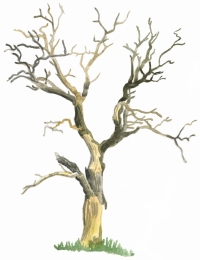A biologically valuable tree is a mature or old, living or dead tree that provides a home for a variety of living organisms — fungi, mosses, lichens, invertebrates, mammals, and birds.
A biologically valuable tree is any species of:
- a growing large-sized or biologically old tree;
- a hollow tree;
- a snag - a standing dead tree;
- deadwood;
- a mature tree damaged by lightning, fire or storm.
Biodiversity
Biologically valuable trees are habitats for various organisms. These organisms may inhabit the tree temporarily, but some may spend their entire life there. Trees provide extensive opportunities for interaction between different species and ensure the long-term survival of many species. Deadwood is also an important habitat for various groups of organisms.
The competition between species (for suitable nesting sites and food resources nearby) is much more intense when the availability of suitable habitats for a species is reduced.






